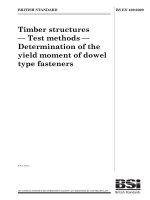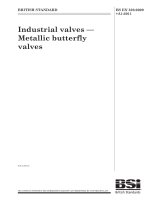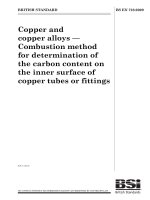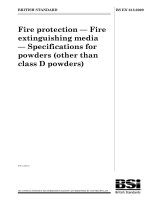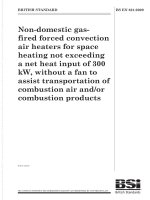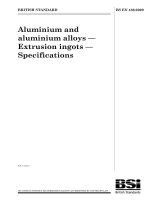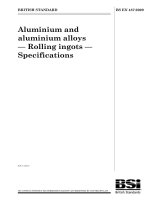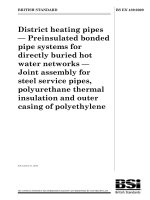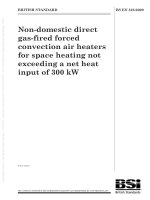Bsi bs en 61822 2009
Bạn đang xem bản rút gọn của tài liệu. Xem và tải ngay bản đầy đủ của tài liệu tại đây (1.74 MB, 32 trang )
BS EN 61822:2009
BSI British Standards
Electrical installations for
lighting and beaconing of
aerodromes — Constant
current regulators
NO COPYING WITHOUT BSI PERMISSION EXCEPT AS PERMITTED BY COPYRIGHT LAW
raising standards worldwide™
BRITISH STANDARD
BS EN 61822:2009
National foreword
This British Standard is the UK implementation of EN 61822:2009. It is
identical to IEC 61822:2009. It supersedes BS EN 61822:2003 which is
withdrawn.
The UK participation in its preparation was entrusted to Technical Committee
EPL/97, Aeronautical ground lighting.
A list of organizations represented on this committee can be obtained on
request to its secretary.
This publication does not purport to include all the necessary provisions of a
contract. Users are responsible for its correct application.
© BSI 2009
ISBN 978 0 580 59226 3
ICS 29.140.50; 93.120
Compliance with a British Standard cannot confer immunity from
legal obligations.
This British Standard was published under the authority of the Standards
Policy and Strategy Committee on 31 October 2009
Amendments issued since publication
Amd. No.
Date
标准分享网 www.bzfxw.com 免费下载
Text affected
BS EN 61822:2009
EUROPEAN STANDARD
EN 61822
NORME EUROPÉENNE
July 2009
EUROPÄISCHE NORM
ICS 29.140.50; 93.120
Supersedes EN 61822:2003
English version
Electrical installations for lighting and beaconing of aerodromes Constant current regulators
(IEC 61822:2009)
Installations électriques pour l'éclairage
et le balisage des aérodromes Régulateurs de courant constant
(CEI 61822:2009)
Elektrische Anlagen für Beleuchtung
und Befeuerung von Flugplätzen Konstantstromregler
(IEC 61822:2009)
This European Standard was approved by CENELEC on 2009-06-01. CENELEC members are bound to comply
with the CEN/CENELEC Internal Regulations which stipulate the conditions for giving this European Standard
the status of a national standard without any alteration.
www.bzfxw.com
Up-to-date lists and bibliographical references concerning such national standards may be obtained on
application to the Central Secretariat or to any CENELEC member.
This European Standard exists in three official versions (English, French, German). A version in any other
language made by translation under the responsibility of a CENELEC member into its own language and notified
to the Central Secretariat has the same status as the official versions.
CENELEC members are the national electrotechnical committees of Austria, Belgium, Bulgaria, Cyprus, the
Czech Republic, Denmark, Estonia, Finland, France, Germany, Greece, Hungary, Iceland, Ireland, Italy, Latvia,
Lithuania, Luxembourg, Malta, the Netherlands, Norway, Poland, Portugal, Romania, Slovakia, Slovenia, Spain,
Sweden, Switzerland and the United Kingdom.
CENELEC
European Committee for Electrotechnical Standardization
Comité Européen de Normalisation Electrotechnique
Europäisches Komitee für Elektrotechnische Normung
Central Secretariat: Avenue Marnix 17, B - 1000 Brussels
© 2009 CENELEC -
All rights of exploitation in any form and by any means reserved worldwide for CENELEC members.
Ref. No. EN 61822:2009 E
BS EN 61822:2009
EN 61822:2009
-2-
Foreword
The text of document 97/135/FDIS, future edition 2 of IEC 61822, prepared by IEC TC 97, Electrical
installations for lighting and beaconing of aerodromes, was submitted to the IEC-CENELEC parallel vote
and was approved by CENELEC as EN 61822 on 2009-06-01.
This European Standard supersedes EN 61822:2003.
EN 61822:2009 includes the following significant technical changes with respect to EN 61822:2003:
– revision and update of terms and definitions;
– addition of new subclauses, such as "Nominal output current range and tolerances";
– modification of some subclauses, such as those related to "Local control" and "Remote control";
– deletion of some subclauses, in particular "Power transformers" and "Output current indicator".
The following dates were fixed:
– latest date by which the EN has to be implemented
at national level by publication of an identical
national standard or by endorsement
(dop)
2010-03-01
– latest date by which the national standards conflicting
with the EN have to be withdrawn
(dow)
2012-06-01
Annex ZA has been added by CENELEC.
www.bzfxw.com
__________
Endorsement notice
The text of the International Standard IEC 61822:2009 was approved by CENELEC as a European
Standard without any modification.
__________
标准分享网 www.bzfxw.com 免费下载
BS EN 61822:2009
EN 61822:2009
-3-
Annex ZA
(normative)
Normative references to international publications
with their corresponding European publications
The following referenced documents are indispensable for the application of this document. For dated
references, only the edition cited applies. For undated references, the latest edition of the referenced
document (including any amendments) applies.
NOTE When an international publication has been modified by common modifications, indicated by (mod), the relevant EN/HD
applies.
Year
Publication
1)
Title
IEC standard voltages
2)
EN/HD
Year
HD 472 S1
+ corr. February
A1
1989
2002
1995
EN 60439-1
1999
3)
IEC 60038 (mod)
-
IEC 60439-1
1999
IEC 60529
-
1)
Degrees of protection provided by enclosures EN 60529
(IP Code)
+ corr. May
1991
1993
3)
IEC 61000-6-2
-
1)
Electromagnetic compatibility (EMC) Part 6-2: Generic standards - Immunity for
industrial environments
EN 61000-6-2
+ corr. September
2005
2005
3)
3)
Low-voltage switchgear and controlgear
assemblies Part 1: Type-tested and partially type-tested
assemblies
www.bzfxw.com
-
1)
Electromagnetic compatibility (EMC) Part 6-4: Generic standards - Emission
standard for industrial environments
EN 61000-6-4
2007
IEC/TS 61000-6-5
-
1)
Electromagnetic compatibilty (EMC) Part 6-5: Generic standards - Immunity for
power station and substation environments
-
-
IEC 61024-1
-
1)
Protection of structures against lightning Part 1: General principles
-
-
IEC 61140
-
1)
Protection against electric shock - Common
aspects for installation and equipment
EN 61140
2002
IEC 61439-1
2009
Low-voltage switchgear and controlgear
assemblies Part 1: General rules
-
-
IEC 62305-1
-
1)
Protection against lightning Part 1: General principles
EN 62305-1
+ corr. November
2006
2006
3)
IEC 62305-3 (mod) -
1)
Protection against lightning EN 62305-3
Part 3: Physical damage to structures and life + corr. September
hazard
+ A11
2006
2008
2009
3)
CISPR 11 (mod)
1)
Industrial scientific and medical (ISM)
EN 55011
radio-frequency equipment - Electromagnetic
disturbance characteristics - Limits and
methods of measurement
2007
3)
IEC 61000-6-4
-
1)
Undated reference.
2)
The title of HD 472 S1 is: Nominal voltages for low-voltage public electricity supply systems .
3)
Valid edition at date of issue.
3)
BS EN 61822:2009
EN 61822:2009
Publication
CISPR 22
-4Year
-
1)
Title
EN/HD
Year
Information technology equipment - Radio
disturbance characteristics - Limits and
methods of measurement
-
-
www.bzfxw.com
标准分享网 www.bzfxw.com 免费下载
–2–
BS EN 61822:2009
61822 © IEC:2009
CONTENTS
FOREWORD...........................................................................................................................4
1
Scope ...............................................................................................................................6
2
Normative references........................................................................................................6
3
Terms and definitions .......................................................................................................7
4
Classification ....................................................................................................................7
5
4.1 Output current .........................................................................................................7
4.2 Current steps...........................................................................................................7
4.3 Ratings ....................................................................................................................7
Requirements ...................................................................................................................8
5.1
5.2
5.3
General ...................................................................................................................8
Environmental requirements ....................................................................................8
Performance requirements.......................................................................................8
5.3.1 Nominal output current range and tolerances ...............................................8
5.3.2 Regulation – resistive loading.......................................................................9
5.3.3 Regulation – reactive loading .......................................................................9
5.3.4 Efficiency.....................................................................................................9
5.3.5 Power factor ................................................................................................9
5.3.6 Input voltage ................................................................................................9
5.3.7 Load matching .............................................................................................9
5.3.8 Operation ....................................................................................................9
5.3.9 Control/Monitoring System ...........................................................................9
5.3.10 Output current surge limitation ................................................................... 11
5.3.11 Dynamic response ..................................................................................... 11
5.3.12 Output voltage limitation ............................................................................ 11
5.3.13 Protective devices...................................................................................... 11
Electromagnetic compatibility (EMC) ...................................................................... 12
5.4.1 Limits for emission ..................................................................................... 12
5.4.2 Output current waveform ............................................................................ 12
5.4.3 Limits for immunity..................................................................................... 12
Design requirements.............................................................................................. 12
5.5.1 Local control .............................................................................................. 12
5.5.2 Local indication .......................................................................................... 12
5.5.3 Wiring diagram .......................................................................................... 12
5.5.4 Mechanical design ..................................................................................... 12
5.5.5 Electrical design ........................................................................................ 13
5.5.6 Nameplate ................................................................................................. 14
5.5.7 Instruction manual ..................................................................................... 14
Protection against electric shock ............................................................................ 14
Optional accessories ............................................................................................. 15
5.7.1 Earth fault monitor ..................................................................................... 15
5.7.2 Load indicator ............................................................................................ 15
5.7.3 Lamp fault indicator ................................................................................... 15
5.7.4 Output lightning arrestors ........................................................................... 16
5.7.5 Field circuit isolator .................................................................................... 16
5.7.6 Non-illumination current step...................................................................... 16
5.7.7 Out of range indicator ................................................................................ 16
www.bzfxw.com
5.4
5.5
5.6
5.7
BS EN 61822:2009
61822 © IEC:2009
–3–
6
5.7.8
5.7.9
5.7.10
Qualification
7
6.1 Type tests ............................................................................................................. 17
6.2 Routine tests ......................................................................................................... 17
Tests description for tests ............................................................................................... 18
7.1
7.2
7.3
7.4
7.5
7.6
7.7
Output ammeter ......................................................................................... 16
Short circuit protection ............................................................................... 16
Serial wiring ............................................................................................... 17
and test requirements ................................................................................. 17
Visual inspection ................................................................................................... 18
Protection against electric shock ............................................................................ 19
7.2.1 Verification of protection by enclosures ...................................................... 19
7.2.2 Verification of clearances and creepage distances ..................................... 19
Dielectric test ........................................................................................................ 19
7.3.1 Dielectric strength ...................................................................................... 19
7.3.2 Basic impulse insulation level (BIL) test for power transformer ................... 19
Enclosure temperature test .................................................................................... 19
Test of protective devices ...................................................................................... 20
7.5.1 Open circuit test ........................................................................................ 20
7.5.2 Overcurrent test ......................................................................................... 21
Operation test........................................................................................................ 21
Performance test ................................................................................................... 22
7.7.1 Regulation test........................................................................................... 22
7.7.2 Efficiency testing........................................................................................ 22
7.7.3 Power factor .............................................................................................. 23
7.7.4 Output current surge limitation ................................................................... 23
7.7.5 Dynamic response ..................................................................................... 23
7.7.6 Power supply interruptions and voltage dips ............................................... 23
7.7.7 Mechanical operation test .......................................................................... 23
7.7.8 Electromagnetic compatibility (EMC) .......................................................... 24
7.7.9 Lightning arrestors ..................................................................................... 24
Environmental tests ............................................................................................... 24
7.8.1 Low temperature ........................................................................................ 24
7.8.2 High temperature ....................................................................................... 25
Optional accessories ............................................................................................. 25
www.bzfxw.com
7.8
7.9
Figure 1 – Nameplate ............................................................................................................ 14
Figure 2 – Open circuit test schematic diagram ..................................................................... 20
Table 1 – Standard CCR output current step pre-settings ........................................................8
Table 2 – CCR remote control/monitoring functions ............................................................... 10
Table 3 – Lamp failure indicator ............................................................................................ 15
Table 4 – Type and routine tests ........................................................................................... 18
Table 5 – BIL test.................................................................................................................. 19
Table 6 – Resistive loading test ............................................................................................. 22
Table 7 – Reactive loading test ............................................................................................. 22
标准分享网 www.bzfxw.com 免费下载
–4–
BS EN 61822:2009
61822 © IEC:2009
INTERNATIONAL ELECTROTECHNICAL COMMISSION
____________
ELECTRICAL INSTALLATIONS FOR LIGHTING
AND BEACONING OF AERODROMES –
CONSTANT CURRENT REGULATORS
FOREWORD
1) The International Electrotechnical Commission (IEC) is a worldwide organization for standardization comprising
all national electrotechnical committees (IEC National Committees). The object of IEC is to promote
international co-operation on all questions concerning standardization in the electrical and electronic fields. To
this end and in addition to other activities, IEC publishes International Standards, Technical Specifications,
Technical Reports, Publicly Available Specifications (PAS) and Guides (hereafter referred to as “IEC
Publication(s)”). Their preparation is entrusted to technical committees; any IEC National Committee interested
in the subject dealt with may participate in this preparatory work. International, governmental and nongovernmental organizations liaising with the IEC also participate in this preparation. IEC collaborates closely
with the International Organization for Standardization (ISO) in accordance with conditions determined by
agreement between the two organizations.
2) The formal decisions or agreements of IEC on technical matters express, as nearly as possible, an international
consensus of opinion on the relevant subjects since each technical committee has representation from all
interested IEC National Committees.
3) IEC Publications have the form of recommendations for international use and are accepted by IEC National
Committees in that sense. While all reasonable efforts are made to ensure that the technical content of IEC
Publications is accurate, IEC cannot be held responsible for the way in which they are used or for any
misinterpretation by any end user.
4) In order to promote international uniformity, IEC National Committees undertake to apply IEC Publications
transparently to the maximum extent possible in their national and regional publications. Any divergence
between any IEC Publication and the corresponding national or regional publication shall be clearly indicated in
the latter.
www.bzfxw.com
5) IEC provides no marking procedure to indicate its approval and cannot be rendered responsible for any
equipment declared to be in conformity with an IEC Publication.
6) All users should ensure that they have the latest edition of this publication.
7) No liability shall attach to IEC or its directors, employees, servants or agents including individual experts and
members of its technical committees and IEC National Committees for any personal injury, property damage or
other damage of any nature whatsoever, whether direct or indirect, or for costs (including legal fees) and
expenses arising out of the publication, use of, or reliance upon, this IEC Publication or any other IEC
Publications.
8) Attention is drawn to the Normative references cited in this publication. Use of the referenced publications is
indispensable for the correct application of this publication.
9) Attention is drawn to the possibility that some of the elements of this IEC Publication may be the subject of
patent rights. IEC shall not be held responsible for identifying any or all such patent rights.
International Standard IEC 61822 has been prepared by IEC Technical Committee 97:
Electrical installations for lighting and beaconing of aerodromes.
This second edition cancels and replaces the first edition published in 2002. It is a technical
revision.
This edition includes the following significant technical changes with respect to the previous
edition:
a) revision and update of terms and definitions;
b) addition of new paragraphs, such as "Nominal output current range and tolerances";
c) modification of some paragraphs, such as those related to "Local control" and "Remote
control";
d) deletion of some paragraphs, in particular "Power transformers" and "Output current
indicator".
BS EN 61822:2009
61822 © IEC:2009
–5–
The text of this standard is based on the following documents:
FDIS
Report on voting
97/135/FDIS
97/139/RVD
Full information on the voting for the approval of this standard can be found in the report on
voting indicated in the above table.
This publication has been drafted in accordance with the ISO/IEC Directives, Part 2.
The committee has decided that the contents of this publication will remain unchanged until the
maintenance result date indicated on the IEC web site under "" in the data
related to the specific publication. At this date, the publication will be
•
•
•
•
reconfirmed,
withdrawn,
replaced by a revised edition, or
amended.
www.bzfxw.com
标准分享网 www.bzfxw.com 免费下载
–6–
BS EN 61822:2009
61822 © IEC:2009
ELECTRICAL INSTALLATIONS FOR LIGHTING
AND BEACONING OF AERODROMES –
CONSTANT CURRENT REGULATORS
1
Scope
This International Standard specifies the requirements for a Constant Current Regulator (CCR)
having a nominal output of 6,6 A for use in an aeronautical ground lighting constant current
series circuit. However, CCRs may be manufactured which have a different power rating (kVA)
and current steps than those specified in this standard in order to be used on existing circuits.
This standard should be applied where appropriate for these CCRs.
2
Normative references
The following referenced documents are indispensable for the application of this document. For
dated references, only the edition cited applies. For undated references, the latest edition of
the referenced document (including any amendments) applies.
IEC 60038, IEC standard voltages
IEC 60439-1:1999, Low-voltage switchgear and control gear assemblies – Part 1: Type-tested
and partially type-tested assemblies
www.bzfxw.com
IEC 60529, Degrees of protection provided by enclosures (IP Code)
IEC 61000-6-2, Electromagnetic compatibility (EMC) – Part 6-2: Generic standards – Immunity
for industrial environments
IEC 61000-6-4, Electromagnetic compatibility (EMC) – Part 6-4: Generic standards – Emission
standard for industrial environments
IEC/TS 61000-6-5, Electromagnetic compatibility (EMC) – Part 6-5: Generic standards –
Immunity for power station and substation environments
IEC 61024-1, Protection of structures against lightning – Part 1: General principles
IEC 61140, Protection against electric shock – Common aspects for installation and equipment
IEC 61439-1:2009, Low-voltage switchgear and controlgear assemblies – Part 1: General rules
IEC 62305-1, Protection against lightning – Part 1: General principles
IEC 62305-3, Protection against lightning – Part 3: Physical damage to structures and life
hazard
CISPR 11, Industrial, scientific and medical (ISM) radio-frequency equipment – Electromagnetic
disturbance characteristics – Limits and methods of measurement
CISPR 22, Information technology equipment – Radio disturbance characteristics – Limits and
methods of measurement
BS EN 61822:2009
61822 © IEC:2009
3
–7–
Terms and definitions
For the purposes of this document, the following terms and definitions developed to be
included in international standards relating to airport/aerodrome visual aids apply
3.1
aeronautical ground lighting (AGL) constant current series circuit
apparatus configured as an electrical circuit designed to produce and operate with a constant
current, independent of variations in the load, in order to provide a specified light output for
aeronautical purposes
3.2
constant current regulator (CCR)
apparatus which produces a current output at a constant r.m.s. value independent of variations
in the constant current series circuit load, input voltage and service conditions as specified
3.3
open circuit
AGL constant current series circuit with an unplanned interruption at any location of the primary
current line that produces a hazardous high voltage between the interrupted circuit sections
3.4
forced ventilation
cooling system in which the air is moved by external power
3.5
live
electrically connected to a source of electricity or having acquired a charge by other means
4
www.bzfxw.com
Classification
4.1
Output current
The CCR shall produce a maximum rated r.m.s. current output of 6,6 A and a minimum rated
r.m.s. current output of 1,8 A.
4.2
Current steps
CCRs shall be classified according to the number of output current steps available, as follows:
•
style 1 : 3 current steps;
•
style 2 : 5 current steps.
Each step shall have a single adjustment over the full range specified in 4.1.
NOTE An additional low current step(s) for non-illumination purposes may be offered as an option (see 5.7.6).
Each style CCR can be configured to operate with a reduced number of current steps.
4.3
Ratings
CCRs shall be manufactured in the following output power ratings:
1 kVA; 2,5 kVA; 5 kVA; 7,5 kVA; 10 kVA; 15 kVA; 20 kVA; 25 kVA; and 30 kVA.
NOTE 1 There may be situations where greater power rating is required than that specified in this International
Standard to meet existing circuit requirements. In this case, the CCR should meet the applicable performance,
qualification and safety requirements contained in this International Standard.
标准分享网 www.bzfxw.com 免费下载
BS EN 61822:2009
61822 © IEC:2009
–8–
The nominal input voltage to the CCR (see 5.3.6) shall be a single-phase or multiple phase
value in accordance with IEC 60038.
The operating frequency shall be 50 Hz ± 7,5 % or 60 Hz ± 7,5 %.
NOTE 2
5
The CCR may be designed to operate from a d.c. power source.
Requirements
5.1
General
The following requirements are grouped into six categories: environmental, performance, EMC,
design, protection against electric shock and optional accessories.
5.2
Environmental requirements
The equipment shall be designed for continuous indoor operation without derating, under the
following conditions:
–
temperature range from 0 °C to +50 °C;
–
relative humidity from 10 % to 95 % without dewing;
–
altitude from sea-level to 1 000 m;
–
electromagnetic compatibility – as per IEC 61000-6-2.
5.3
www.bzfxw.com
Performance requirements
5.3.1
Nominal output current range and tolerances
The nominal output current range is:
•
Style 1: 4,8 A to 6,6 A;
•
Style 2: 2,8 A to 6,6 A.
Table 1 gives the standard pre settings of the CCR. These settings may be varied according to
the requirements of an airport.
Table 1 – Standard CCR output current step pre-settings
Style
Current step
Nominal output
current
A (r.m.s.)
1
2
3
6,60
2
5,50
1
4,80
5
6,60
4
5,20
3
4,10
2
3,40
1
2,80
Tolerance of ± 0,1 A for each current step setting within the nominal output current range.
BS EN 61822:2009
61822 © IEC:2009
5.3.2
–9–
Regulation – resistive loading
While powering any resistive load between no load (short circuit) and full load, the CCR shall
provide an output current within the specified tolerance for each current step setting within the
nominal output current range.
CCRs shall provide regulation over the full range of environmental conditions specified in 5.2
and within the input voltage range of 90 % to 110 %.
5.3.3
Regulation – reactive loading
The CCR shall maintain the current within the specified tolerance for each current step setting
within the nominal output current range when the load has an inductive power factor of 0,60.
5.3.4
Efficiency
At all current steps, the average efficiency of the CCR, operating at rated input voltage into a
full nominal resistive load shall not be less than 80 %.
5.3.5
Power factor
The power factor of the CCR, operating at rated input voltage into a full nominal resistive load
shall not be less than 0,90.
5.3.6
Input voltage
Input voltage shall be as stated in 4.3. The CCR shall operate as required in 5.3.1 when the
input voltage is anywhere between 90 % and 110 % of the nominal input.
www.bzfxw.com
The CCR shall be designed to withstand momentary increases of voltage up to 120 % and
momentary decreases of voltage down to 80 % of the nominal input voltage without being deenergized or damaged by such voltages. The CCR shall withstand such voltage excursions for
up to 50 ms within a period of 1 min. The CCR shall automatically resume normal operation
(Table 1) when the input voltage returns to 90 % to 110 % of the nominal value.
5.3.7
Load matching
CCRs shall match connected loads from 50 % to 100 % of the rated load.
For resistive loads in the range of 50 % to 100 % of the rated load, at the rated input voltage,
and with an output current at 100 %, the efficiency and power factor shall not be less than the
values specified in 5.3.4 and 5.3.5. If required, additional output load taps may be provided to
allow a more precise adjustment or lower load matching.
5.3.8
Operation
The CCR shall stabilize the output current at any selected current step within 500 ms, and shall
hold the output current stable within the specified tolerance of the nominal output current.
There shall not be any interruption of output current to the series circuit when switching from
one current step to another .
5.3.9
5.3.9.1
Control/Monitoring System
Functions
The CCR shall be capable of being controlled locally and from a remote location. Information
on the selected current step and remote/local status shall be provided at the CCR regardless of
whether the CCR is in local or remote control.
标准分享网 www.bzfxw.com 免费下载
BS EN 61822:2009
61822 © IEC:2009
– 10 –
The local control system shall be integral to the CCR and shall not be supplied from a source
located outside the CCR package. The CCR shall be capable of being controlled remotely for
any current level by parallel wiring or serial interface. The design of the remote control
interface shall provide, at least, the inputs and outputs described in Table 2.
Table 2 – CCR remote control/monitoring functions
Remote control
Standard
a
b
Remote monitoring
Option
On/Off selection
Current step selection
Standard
Option
a
CCR on
b
Local/Remote
c
Step 1 selected
c1
Step 1 obtained
d
Step 2 selected
d1
Step 2 obtained
e
Step 3 selected
e1
Step 3 obtained
f
Step 4 selected
f1
Step 4 obtained
g
Step 5 selected
g1
Step 5 obtained
h
CCR out of range
I
Open circuit trip
J
Over current trip
c
CCR Non-illumination
step
k
CCR non-illumination
step
d
Circuit Selector Switch
l
Circuit selector fault
www.bzfxw.com
m
NOTE
Lamp fault warning
n
Lamp fault alarm
o
Earth fault warning
p
Earth fault alarm
For the monitoring section, if (c1) to (g1) is implemented, (c) to (g) can be omitted
5.3.9.2
Control interface
The standard source voltage for controlling and monitoring the CCR shall be +24 V d.c,
+48 V d.c., or +60 V d.c. nominal, with the negative pole being common. Remote control power
shall be provided from a source either external or internal to the CCR. If internal, a dedicated
power supply shall be for remote control only.
Relays or other isolating devices shall be provided for switching on and setting the current
steps of the CCR.
Monitoring of the CCR data output shall be provided by relay contacts or another isolating
device rated at minimum 60 V d.c. and 50 mA. Where a common pole is used, it shall be
negative.
Terminal blocks or connectors having a minimum voltage rating of 300 V shall be installed in
the control cabinet for connection of external wiring associated with monitoring and remote
control. Terminal blocks or connectors shall accommodate 0,250 mm 2 to 2,500 mm 2 cable with
a minimum insulation rating of 300 V. Space for spare positions shall be provided to accommodate optional devices.
5.3.9.3
Monitoring terminals
One terminal for each of the functions listed in 5.3.9.1 shall be provided.
BS EN 61822:2009
61822 © IEC:2009
5.3.10
– 11 –
Output current surge limitation
The CCR shall be designed with a controlled feature, so that switching the CCR on and off,
changing current steps, or shorting the load, shall not damage the CCR, trip a protective
device, nor produce output current surges (transients) that will damage series circuit
equipment. Changes of intensity due to switching of current steps in local or remote control
shall occur without over-shoots exceeding 6,7 A r.m.s.
5.3.11
Dynamic response
For sudden load variations exceeding 10 % of the load, the duration of the possible over
current condition shall be limited to one half-cycle. If the peak current reaches twice the
maximum peak current while in normal operation, (i.e. peak current in short circuit at maximum
current and maximum input voltage) or the current reaches 125 % of the maximum r.m.s.
value, the current shall be limited under 2,0 A r.m.s. after the half sine wave in progress. The
suppression shall remain for one to four cycles and then the current limits of Table 1 shall be
achieved in 500 ms or less.
5.3.12
Output voltage limitation
With the open circuit protection disabled, the peak output voltage of an open-circuited CCR
shall not exceed twice the rated r.m.s. output kVA divided by the rated r.m.s. output current.
5.3.13
Protective devices
5.3.13.1
Open circuit protection
www.bzfxw.com
The CCR shall include an open-circuit protective device to de-energize the CCR output within
1 s after an open circuit condition occurs in the primary series circuit. The protective device
shall be reset manually from the local position only. The CCR shall not trip out due to the
switching of load circuits or other transients.
5.3.13.2
Overcurrent protection
The CCR shall include an overcurrent protective device to de-energize the CCR output
between 3 s and 5 s when the output current exceeds 6,75 A r.m.s. The CCR shall de-energize
the output within 300 ms when the output current exceeds 8,30 A r.m.s. The protective device
shall be reset manually from the local position only.
5.3.13.3
Primary switching
The CCR shall have an electro-mechanical isolating device that interrupts the input power
before it reaches the main power transformer and shall not interrupt internal control power.
5.3.13.4
Input power loss
In the event of an input power loss for up to 1 min, the CCR shall resume operation on the
selected current setting within 500 ms after the restoration of input power.
NOTE
It is not required to fulfil the 500 ms run up time for a power loss period longer than 1 min.
5.3.13.5
Output series circuit switching
When the CCR is used with a circuit selector, the CCR shall not lock-out or produce surges
that would damage the connected series circuits.
Means shall be provided for interlocking the CCR and circuit selector switch. A breaking switch
in the circuit selector switch shall force the CCR output current to zero while the circuit selector
switch is operating.
标准分享网 www.bzfxw.com 免费下载
– 12 –
5.4
BS EN 61822:2009
61822 © IEC:2009
Electromagnetic compatibility (EMC)
5.4.1
Limits for emission
CCRs shall comply with IEC 61000-6-4, the EMC generic emission standard for industrial
environments. Radiated emission limits shall be in accordance with CISPR 11, class B.
5.4.2
Output current waveform
The CCR shall provide an output current waveform with a crest factor of less than 3,2 at all
current steps at the nominal input voltage and with 10 % resistive load.
5.4.3
Limits for immunity
CCRs shall comply with the generic immunity standards for industrial environments
IEC 61000-6-2, supplemented by applicable parts of IEC/TS 61000-6-5 containing EMC
immunity requirements for power station and substation environments (locations where
apparatus for electricity utilities are installed). CCRs shall comply with requirements for
apparatus installed in type G locations (power stations and medium voltage substations) as
defined in IEC/TS 61000-6-5.
5.5
Design requirements
5.5.1
Local control
The CCR shall be capable of being locally controlled to provide the following functions:
www.bzfxw.com
–
on/off;
–
local/remote control;
–
current steps.
5.5.2
Local indication
The CCR shall provide on the front of the unit an indication for the following:
–
an open-circuit trip-out has occurred;
–
an over current trip-out has occurred;
–
input voltage is present;
–
CCR is set to local or remote control;
–
selected current step;
–
output current is present (if no ammeter is installed according to 5.7.8).
5.5.3
Wiring diagram
A wiring diagram showing all customer connection points shall be permanently readable, and
located in a visible place in the CCR.
5.5.4
Mechanical design
The CCR shall be constructed only of materials capable of withstanding the mechanical,
electrical, and thermal stresses as well as the effects of humidity, which are likely to be
encountered in normal service.
Protection against corrosion shall be ensured by the use of suitable materials or by the
application of equivalent protective coatings to the exposed surface, taking account of the
intended conditions of use and maintenance.
BS EN 61822:2009
61822 © IEC:2009
– 13 –
All enclosures and partitions shall be of a mechanical strength sufficient to withstand the
stresses to which they may be subjected in normal service.
The CCR cabinet shall be designed for ease of installation movement of the unit (e.g. rollers,
lifting rings, etc.).
If a CCR is designed as a distributed system where parts of the CCR are not in the same
housing, the cabling used for interconnection between the separated parts has to be defined by
the manufacturer.
The apparatus and circuits in the CCR shall be so arranged as to facilitate their operation and
maintenance and at the same time to ensure the necessary degree of safety.
The CCR shall be designed and arranged in such a way that certain operations, according to
agreement between manufacturer and user, can be performed when the CCR is connected
to the mains.
Such operations may be:
a) visual inspection of
•
switching devices and other apparatus,
•
settings and indicators,
•
conductor connections and markings;
b) adjusting and resetting of relays, releases and electronic devices;
www.bzfxw.com
c) certain fault location operations.
Necessary measures shall be taken to enable maintenance of the CCR, with adjacent
functional units or groups energized. Such measures may be:
–
sufficient space between subassemblies;
–
use of barrier protected sub-sections for each subassembly;
–
use of compartments for each subassembly;
–
insertion of additional protective means provided or specified by the manufacturer.
5.5.5
Electrical design
All components used in the design of the CCR shall be suitable for their function and shall not
operate in excess of 80 % of the component manufacturer’s recommended rating. In order to
maximize reliability, it is recommended that no forced ventilation be utilized. If either is used, it
shall be monitored with an alarm given upon failure. Upon failure of the cooling or heating
element, the CCR shall continue to operate normally for a period of time specified by the
manufacturer.
All cabling and small wiring shall be securely placed in systematic runs and coded where
terminated. Power cabling shall be terminated with lugs or eyes and terminals shall be clearly
and appropriately coded. Wiring identification shall be in agreement with the indicators on
wiring diagrams and drawings. Bushings, glands, or grommets shall protect cabling and wiring
passing through metal work.
The protective earth conductor shall be readily distinguishable by twin coloured green and
yellow markings. When the protective conductor is an insulated single core cable, this colour
identification shall be used throughout the entire length.
Insulated conductors shall be rated for at least the maximum voltage of the circuit concerned.
标准分享网 www.bzfxw.com 免费下载
BS EN 61822:2009
61822 © IEC:2009
– 14 –
Cables between two connecting devices shall have no intermediate splices or soldered joints.
Connections shall be made at fixed terminals. The connection of two or more conductors to
one terminal is permissible only in those cases where the terminals are designed for this
purpose.
5.5.6
Nameplate
A permanently readable nameplate (Figure 1) with the information listed below shall be
securely attached to a visible location on the exterior of the CCR enclosure. If the nameplate is
attached to a readily removable surface, such as a cover, the serial number shall be duplicated
in a permanent conspicuous place elsewhere on the CCR.
Constant current regulator
Manufacturer’s name and part number:
Number of current steps:
Input:
V
Hz
Remote control voltage:
Output:
V d.c. or serial physical layer:
kVA at 6,6 A. Maximum output voltage:
V
Serial number:
Year of manufacture:
Figure 1 – Nameplate
5.5.7
IEC
1609/02
www.bzfxw.com
Instruction manual
The manufacturer shall specify in its instruction manuals the conditions for the installation,
operation and maintenance of the CCR and the equipment contained herein.
The instructions for the transport, installation and operation of the CCR shall indicate the
measures that are of particular importance for the proper and correct installation, commissioning and operation of the CCR.
The instruction manual shall include the following:
–
theory of operation;
–
wiring and control diagrams;
–
general operation;
–
installation instructions;
–
preventive maintenance;
–
spare parts list;
–
troubleshooting;
–
revision information including firmware (if applicable);
–
options.
5.6
Protection against electric shock
CCRs shall be provided with protection against electric shock in accordance with the
fundamental rules outlined in IEC 61140.
For provision of equipotential bonding and connection of protective conductors, refer to
IEC 61439-1.
BS EN 61822:2009
61822 © IEC:2009
– 15 –
The degree of protection provided by the cabinet containing a CCR assembly against contact
with live parts or ingress of solid bodies and liquid shall be indicated by the IP designation,
according to IEC 60529.
For CCR assemblies for indoor use where there is no requirement for protection against
ingress of water, the degree of protection shall be at least IP2X after installation in accordance
with the manufacturer’s instructions.
For CCR assemblies for outdoor use having no supplementary protection, the second numeral
shall be at least 3.
High voltage equipment (1 000 V or greater), including the power transformer, shall be isolated
from the low voltage equipment either by construction when they are in the same assembly, or
by inclusion in a separate switchgear assembly.
The internal access plates shall be fitted with the appropriate IEC warning label.
5.7
Optional accessories
5.7.1
Earth fault monitor
An earth fault indicator may be built into the CCR for monitoring its own output circuit and shall
be designed in one of the following ways.
–
When the CCR is in a brightness step, it shall be designed to apply a d.c. voltage of 500 V
maximum on the output series circuit relative to ground or earth potential.
–
When the CCR is disconnected, it shall be designed to apply a d.c. voltage of 1 000 V
maximum on the output series circuit relative to ground or earth potential.
www.bzfxw.com
The earth fault indicator shall be able to detect an insulation resistance with a minimum range
of 10 kΩ to 50 MΩ.
The insulation resistance reading shall be independent of the current step setting, and of the
location of the fault. The fault shall be measured permanently as soon as the local switch is on
"remote control" position or on a current step setting. If operated at voltages exceeding
70 V d.c., when the CCR is in local-off, this control device shall be automatically switched off.
At least two thresholds (warning and alarm), determined in relation to the local operational
requirement of the airport, shall be offered with information available locally and remotely.
5.7.2
Load indicator
A load indicator may be installed in the CCR in order to indicate the amount of load on the
CCR.
5.7.3
Lamp fault indicator
A lamp fault detector may be installed in the CCR to detect a pre-determined number of burnt
out lamps on the series circuit.
Table 3 – Lamp failure indicator
Range of burnt out lamps in % of
total installed lamps
Required accuracy of the lamp
failure indicator in % of total
installed lamps
≤ 10 %
1%
>10 % to ≤30 %
2%
标准分享网 www.bzfxw.com 免费下载
– 16 –
BS EN 61822:2009
61822 © IEC:2009
Detection shall operate, at a minimum, the top two steps of both CCR types and for all loads
between 25 % and 100 % of the nominal load.
The tolerances are valid for the basic conditions:
•
all lamp transformers of same type;
•
all loads of same wattage;
•
all loads of lamp load;
•
the fault occurred by broken filament.
At least two thresholds (warning and alarm) for the number of lamps out of service shall be
available. These thresholds shall be adjustable from two times the actual accuracy. Local
visual indication shall be provided, as well as remote indication when a lamp out warning or
alarm has occurred.
5.7.4
Output lightning arrestors
The CCR may be fitted with output surge protective devices (SPD).
Where fitted, SPD shall meet the lightning protection requirements of IEC 62305-1 and
IEC 62305-3.
Where fitted, SPD of the size necessary to protect the CCR shall be installed across the CCR
output terminals. The ground side of the SPD shall be connected to the earth terminal of the
enclosure or other suitable earth ground location. The SPD shall have the capability to
withstand a pulse on the output circuit consisting of a 10 μs by 20 μs current surge of 15 000 A
with a subsequent power-follow current and a voltage surge of 10 000 V/μs minimum without
damaging the CCR.
www.bzfxw.com
5.7.5
Field circuit isolator
The CCR may contain an integral isolating device to allow the isolation of the outgoing field
cables for the purpose of load disconnection, cable insulation resistance testing, and ground
search capability. When operated, the device shall short out the CCR output terminals and
provide access for instrument connection to both of the load side terminals. A facility shall be
provided for earthing the primary series circuit.
5.7.6
Non-illumination current step
A non-illumination current step may be offered to allow the use of accessory devices on the
series circuit. The minimum nominal current value shall be 1,8 A r.m.s. The accuracy of this
option shall be ± 0,1 A.
5.7.7
Out of range indicator
The CCR may contain an out of range indicator for the series circuit. This indicator shall be
installed on the CCR front panel that displays a warning when the current measured for the
selected current step is not within the required limits.
5.7.8
Output ammeter
An r.m.s. reading ammeter may be installed on the front panel of the CCR to indicate output
current. The accuracy shall be better than or equal to ±1 % of the full range (i.e. 6,6 A).
5.7.9
Short circuit protection
The CCR may have short-circuit protection on the primary side of the power transformer
appropriate to the fault current level.
BS EN 61822:2009
61822 © IEC:2009
5.7.10
– 17 –
Serial wiring
All controls and output functions may be optionally available using a serial interface. Output
functions exclusively may be made optionally available via a serial interface.
6
6.1
Qualification and test requirements
Type tests
The type tests shown in Table 4 aim to ensure that the design of the CCR is able to comply
with this standard. Any certification report shall mention compliance to this standard and to any
other applicable standard.
Each CCR design type shall be tested with the largest power rating for each enclosure size. All
tests shall be performed with all optional accessories offered by the manufacturer, which are
defined in 5.7.
The ambient temperature shall be measured during the last quarter of the test period by means
of at least two thermometers or thermocouples equally distributed around the CCR assembly.
The ambient temperature shall be in the range from +10 °C to +40 °C.
In case the CCR is made of several subassemblies, the type test shall be run on a complete
assembly containing subassemblies wired as per the manufacturer's instruction manual. The
test results for the CCR and each subassembly shall be recorded.
6.2
www.bzfxw.com
Routine tests
The following tests, shown in Table 4, shall be carried out at the factory on every CCR
assembly when it is assembled in accordance with a previously accepted type or through the
exclusive use of parts and accessories specified or supplied by the manufacturer for this
purpose and already approved.
The following minimum routine tests shall be undertaken at an ambient temperature in the
range from +10 °C to +40 °C. Additionally, the CCR shall be checked for compliance with the
particular requirements of the purchase order/contract. This check shall at least comprise, but
not be limited to, specific controls, signalling and/or marking.
The results of the routine tests shall be recorded in the test protocol. A copy of these results
shall be included with each CCR.
NOTE The performance of the routine tests at the factory does not relieve the CCR installer from the duty of
checking it after transport and installation.
标准分享网 www.bzfxw.com 免费下载
BS EN 61822:2009
61822 © IEC:2009
– 18 –
Table 4 – Type and routine tests
Test
Type test
Routine test
reference
Visual inspection
X
X
7.1
Safety
X
X
7.2
Power frequency
X
7.3.1
Enclosure temperature
X
7.4
Open circuit
X
X
7.5.1
Overcurrent
X
X
7.5.2
Operation
X
X
7.6
Regulation (resistive load)
X
X
7.7.1.1
Regulation (reactive load)
X
7.7.1.2
Efficiency
X
7.7.2
Power factor
X
7.7.3
Output current surge
X
7.7.4
Dynamic response
X
7.7.5
Power supply interruptions
X
7.7.6
Output waveforms
X
5.4.2
Mechanical operation
X
EMC
X
BIL
X
www.bzfxw.com
7.7.7
7.7.8
X
7.3.2
Lightning arrestors
X
7.7.9
Low temperature
X
7.8.1
X
7.8.2
High temperature
7
Tests description for tests
Calibrated r.m.s. measuring equipment with an accuracy class at least twice the specified
accuracy for the parameter to be measured shall be used. Calibration shall be traceable. When
a variation from a following test description is applicable in the corresponding re-qualification or
routine production tests, the variation is explicitly recorded.
7.1
Visual inspection
The equipment shall be visually inspected for compliance with:
–
manufacturer's data sheet;
–
manufacturer's drawings;
–
manufacturer's instruction manual;
–
this standard regarding name plate position and content;
–
presence of the safety warnings;
–
presence and size of power, earthing and control terminals;
–
presence of equipment (rolling castors, lifting rings, etc.) specified in this International
Standard.
BS EN 61822:2009
61822 © IEC:2009
7.2
– 19 –
Protection against electric shock
7.2.1
Verification of protection by enclosures
The specified degree of protection provided by enclosures shall be verified in accordance with
procedures specified in IEC 60529.
7.2.2
Verification of clearances and creepage distances
It shall be verified that the clearances and creepage distances which comply with values are
consistent with the rated insulation voltages. Tables 1 and 2 included in IEC 61439-1 contain
minimum values for clearances and creepage distances for low voltage circuits. If necessary,
the clearances and creepage distances have to be verified by measurements, taking account of
possible deformation of parts of the enclosure or of the internal screens, including possible
changes in the event of a short-circuit.
NOTE The rated insulation voltage is a voltage value to which dielectric test voltages and creepage distances are
referred. It is assumed that the maximum rated operational voltage of any circuit of the CCR will not, even
temporarily, exceed 110 % of its rated insulation voltage.
7.3
Dielectric test
7.3.1
Dielectric strength
The dielectric strength shall be checked as follows:
a) between output terminals and earth in accordance with 10.9.2 of IEC 61439-1, with the test
voltage being twice the rated insulation voltage plus 2 500 V r.m.s., with the rated insulation
voltage being 1,1 times the maximum operating voltage (when the CCR is operating at
maximum rated output current). During this test, the control terminals and low voltage
circuitry shall be bonded to earth;
www.bzfxw.com
b) low voltage input terminals and earth (output and control terminals bonded to earth) in
accordance with 10.9.2 of IEC 61439-1.
7.3.2
Basic impulse insulation level (BIL) test for power transformer
Basic lightning impulse insulation level (BIL) testing of the CCR’s power transformer shall be
performed on both the primary and secondary windings. The terminals of each winding shall be
connected together to the high impulse generator. All other terminals and the core shall be
grounded. Testing shall be performed with a 1,2 μs rise time × 50 μs fall time wave shape at
the nominal peak levels shown below (Table 5) with a negative polarity. One reduced, two
chopped and one full impulse wave shall be applied.
Table 5 – BIL test
Primary BIL
Secondary BIL
Reduced
wave
Chopped
wave
Full wave
Reduced
wave
Chopped
wave
Full wave
kV Peak
kV Peak
kV Peak
kV Peak
kV Peak
kV Peak
Under 10 kVA
7
10
10
7
10
10
10 kVA and 15 kVA
7
10
10
12
20
20
20 kVA, 25 kVA and 30 kVA
7
10
10
18
30
30
Transformer size
7.4
Enclosure temperature test
The CCR shall be installed and wired per manufacturer's instruction manual. The clearances
around the CCR shall be at the minimum specified by the instruction manual.
The enclosure temperature test shall be carried out as follows.
标准分享网 www.bzfxw.com 免费下载
BS EN 61822:2009
61822 © IEC:2009
– 20 –
a) Connect the CCR to a nominal power source and a nominal resistive load.
b) Adjust the CCR for supplying a nominal output current until the temperature has stabilized
(no variation in excess of 1 °C for a period of 1 h). Record the highest temperature spot on
the enclosure. Verify that the temperature on the enclosure does not exceed 15 °C above
the ambient temperature. Record the temperature.
7.5
Test of protective devices
7.5.1
Open circuit test
An open circuit test (see 5.3.13.1) shall be carried out as follows.
The open circuit maximum r.m.s voltage before operation of the protective circuitry should not
exceed twice the nominal r.m.s. output voltage (rated r.m.s. output kVA divided by the r.m.s.
output current).
a) Force or adjust the CCR output current to between 1,30 A and 1,50 A (I 0 ). Check that the
power to the output transformer is switched off within 1 s.
b) De-energize the CCR. Remove the load circuit from the output of the CCR.
c) Re-energize the CCR into the highest current step. Check that the power to the output
transformer is switched off within 1 s and record the maximum output voltage.
d) Test for cap load.
1/2 RL
2
S
1/2 RL
www.bzfxw.com
1
CCR
Series
CC
Circuit
IEC 838/09
RL
load resistance
CC
simulation of cable capacitance
S
switch for simulation of a circuit interrupt
Figure 2 – Open circuit test schematic diagram
1) Preparation
•
Size R L suitable to the nominal load of the CCR (e.g. CCR 15 kVA, RL = ca. 300 Ώ)
•
Deactivate capacitive switch off circuitry “IC – switch off” of the CCR
Open switch S (position 2) and switch on CCR in step 1
•
Adjust C C in a way that a current of 1,1 × I 0 will flow (I0 = open circuit protection current)
•
Afterwards switch off CCR and close switch S again (position 1)
•
Activate capacitive switch off circuitry of the CCR
•
Switch on CCR in all current steps → CCR shall not switch off due to capacitive switch
off circuitry
2) “I C - switch off” Test
